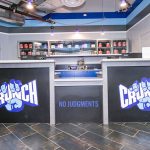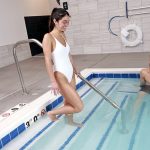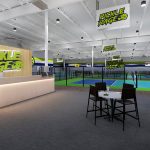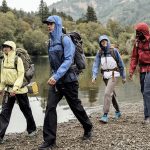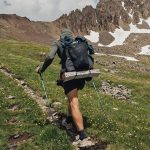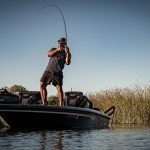The relentless march toward lighter, stronger, faster continues in the backcountry equipment market as evidenced by products exhibited at last month’s Outdoor Retailer Winter Market. Below we provide specific examples in a second installation of The B.O.S.S. Report’s occasional series on what was new and important at the show. For an overview of larger trends driving the backcountry equipment business, see last week’s issue of BOSS (BOSS_1107).
BOOTS: Dynafit’s weighed in with the 1,750-gram Titan Ultralight (MSRP $869.95), a super-stiff Freeride Touring boots suitable for long tours. Ultra-stiff Pebax mix and a carbon fiber heel booster increase support and performance in the most challenging terrain. The alpine overlap construction combined with micro adjustable magnesium buckles allows for wide range of motion for walking, climbing and skinning.
Garmont’s four new Freeride Tour boots feature a rear plate that can be adjusted with a hex nut to offer three forward lean positions and a new water seal gasket to join the shell over the foot.
The line includes the Delirium for men and Asylum for women, its stiffest freeride boots to date for the sidecountry market. The Delirium weighs in at about 2,400 grams and features a wide forefoot for bunions and bone spurs. The Asylum features Garmont’s new EZFIT liners that can be skied without thermoforming. Both skis use a snug heel and a stiffened lower shell for enhanced leverage.
* * * * *
SKIS: This category is filled with alpine companies making lighter, narrower skis and backcountry companies making fatter, heavier skis. Rockered skis, originally developed to keep tips up for skinning and skimming powder, were represented in most lines because they make it so much easier to turn and the rocker can be adjusted to help even the fattest skis negotiate all snow conditions.
Black Diamond introduced its new Power Series of skis, which it says reflects its “mission to united freeride power with backcountry-inspired agility.” The eight-ski collection is aimed at lift assisted runs on powder, piste or hard snow, making it clear BDE expect to meet its goal of quadrupling annual sales to $500 million in the next five years in part by pushing further into the resort alpine market.
The Zealot (MSRP $849.00) and Verdict (MSRP $819.00) skis, for instance, add a layer of Titanal metal sheets for “terrain absorbing dampness through any snow conditions.” The 110 mm-waisted Zealot is optimal for 50% soft snow and 50% hard snow, while the 102mm waisted Verdict is good for 30/70 mix.
At 140/116/127, G3’s 2011/12 version of its top selling Highball (MSRP $769.95) will be the fattest ski ever offered by the backcountry brand. It features G3’s progressive Sweet Rise Camber, which combines rocker for soft snow conditions with a camber for loads of edge pressure on firmer snow and is aimed at the freeride market. It too uses Titanal deck sandwich construction and weighs in at 4.5 pounds per ski. “We been a guide oriented company so we are catching up with the market,” said Scott Deur, North American sales manager for G3. “The guides like more cambered, traditionally European touring ski, but the sidecountry wants more rocker.
* * * * *
BINDINGS: Dynafit’s Radical FT12 (Freeride Tour) (MSRP $599.95) is an example of how the European backcountry brands are catering to the more aggressive North American Freeride skier. The 599-gram binding with DIN 12 setting features toe-side “power towers”, allowing for quick binding entry, increased power transfer, and greater side impact resistance. It comes with an anti-torsion plate for big jumps and lateral rigidity, a speed step climbing bar, and 75mm width and 130 m brake for your fatter skis.
PACKS: Air bags were the big development in this category and now seem destined to become standard issue for serious backcountry skiers. “These have been around 25 years but there has been a big push recently because there has been more testing and real world data proves they pretty much work,” noted David Furman, hardgoods category manager for Mammut, which launched its own line of air bag systems at the show. “If you are caught in an avalanche slide, you have a 50% chance of being buried without a bag. With a bag, that goes down to somewhere near 5%. I think this is a really important topic in avalanche safety and will really grow.”
Mammut will enter the business next season with a 22- and 30-liter pack (MSRP $679-$699) that uses a modular air bag and venturi (inflation) system that can be moved between packs. Refillable cartridges are available for $175. “In the future you will be able to move our air bag between a 15- and 40-liter backpack as you move between yo-yo skiing and backcountry,” Furman said of the system, which is being licensed from fellow Swiss company Snowpulse.
Backcountry Access introduced the Float 18 (MSRP $685) and Float 36 (MSRP $785) on either side of its existing Float 30 (MSRP $750), which has been a big hit with backcountry skiers and snowmobilers alike. The Float 18 is aimed at “slackcountry” skiers who yo-yo up and down the mountain using lifts and snowmobilers looking for a lower profile pack. These enthusiasts still need to carry shovels and probes, but don’t need as much room in their pack for extra layers and food. BCA has had a lot of success with the Float 30 because it’s priced well below European competitors, in large part because of the company’s just patented venture system, which allows it to use much smaller 2,700-psi compress air cylinders that can be refill cheaply at SCUBA, paintball and select outdoor retail shops.
* * * * *
SHOVELS: K2 introduced its first complete line of backcountry tools at the show, including shovels, probes, climbing skins, poles and packs. The company has emphasized versatility. It’s shovels for instance have slot that allow them not only to be used as a dead man anchor but be combined with its skis and poles to construct an emergency litter. The shovel’s handle can be configured for hoeing rather than shoveling. The company improved the stiffness of its probes by 30% and integrated inclinometers into its poles so users can quickly gauge the angle of a slope without removing gear from their pack.
BCA’s completely redesigned its avalanche shovels with a more contoured, industrial look that makes them more compact, stronger and gives them more shelf appeal. The Arsenal line features an integrated 240-cm probe and 35-cm saw, while the Bomber series (B-1, B-2 and B-3) features a contoured design and more shallow neck that sheds weight and makes them more packable.
* * * * *
BEACONS: Here manufacturers are still searching for the right balance of features, ease of use and price. Mammut, for instance, introduced the Pulse Element Barryvox (MSRP $350), a slimmed down version of the Pulse (MSRP $490), which was introduced in 2006 for the professional market. The Pulse uses signal separation, which allows rescuers to distinguish between separate signals in a mass burial situation.
Some have rejected the feature as too complicated and time consuming given the rarity of multiple burials, so Mammut introduced basic and advanced user profiles in the beacons in 2009. For 2011-12, Mammut will take it a step further by stripping out the motion detector, the analog mode and the user profile settings to create a less expensive and easier to use Pulse Element. “You can add all the features in the world,” Furman noted. “But if people don't want it, you can't sell it.”
* * * * *
PROBES: G3 cuts its probe SKUs in half and their individual weights by 15% with the introduction of its new line of aluminum and carbon Speed Tech probes, which come in 198, 328, 248, 3080 centimeter versions (MSRP $54.95-$84.95). All the probes are etched their entire length with 5mm lines and feature a new single-pull, quick deployment handle to shave seconds of rescue times and add stiffness. G3 lowered its probe prices by about $15 a piece.
B.O.S.S. Report’s occasional series on what was new and important at the show. For an overview of larger trends driving the backcountry equipment business, see last week’s issue of BOSS (BOSS_1107).

